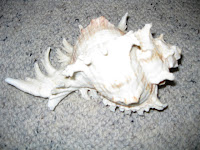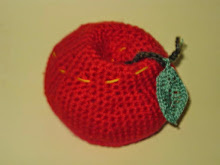The Original Equation for crocheting or knitting a seashell was given in post: 21 June 2010 etc.
F(n) = 2 x F(n-2) + F(n-3)
F(n+1) = 2 x F(n-1) + F(n-2) eg F9=34 = 2 x 13 + 8.........for knitting, work downwards, knit 2 together.
F(n) = 2 x F(n-2) + F(n-3) eg F8=21= 2 x 8 + 5
F(n-1) = 2 x F(n-3) + F(n-4) eg F7=13= 2 x 5 + 3...........for crocheting, work upwards, crochet twice in same loop.
Patterns are given for spiral seashells:- 23 June 2010, (here are the bivalves).
A green knitted bivalve and a red blue yellow crocheted bivalve were also configured from this Pattern.
***************************
The only bivalve made from the first Bivalve Pattern was a white crocheted model. 23 June 2010.
At the time I guessed that one could knit by working backwards; later it was found to be not possible.
***************************
New Patterns are given recently:- May 26 2011, (the giant clam)
Diagrams and models 1 and 4 have a wavy lip like a clam.
Original working out is given in Fibonacci Fan shapes 1 to 610 and 233 to 6765.
Eventually a giant clam might be properly created- by someone- in fibre, iaw Fibonacci Series of numbers!
***************************
Here are the new Equations:-
From 1/2F(n) to knit next row 1/2F(n-1)
= k2tog x 1/2 F(n-2) + k 1/2 F(n-3)
eg. cast on 117. k2tog x 45, k 27. makes 72, (nb. 0.5 is rounded off)
Fn=233, F(n-2) is 89, F(n-3) is 55, F(n-1) is 144.
From 1/2F(n-1) to crochet 1/2F(n)
= crochet 2x in loop x 1/2F(n-2) + crochet once in loops x 1/2F(n-3).
eg. base 72 loops, crochet 2x in next 45 loops, crochet once in 27 loops, makes 117.
F(n-1)=144, F(n) is 233, F(n-2) is 89, F(n-3) is 55.
and so it goes, even if you were able to knit huge numbers:-
F59 is 956 722 026 041..........half is 478 361 013 020.5
F57 is 365 435 296 162..........half is 182 717 648 081
F56 is 225 851 433 717..........half is 112 925 716 858.5
..............................adding last two:- 295 643 364 939.5
.................which is half F58 ie half of 591 286 729 879
.......................................................................................
Equation was:- from 1/2F59 make 1/2F58 by k2tog x 1/2F57 + k 1/2F56
......................................................................................
One can imagine a creature or single cell figuring out how to multiply its cells or molecules
or how to fuse or divide its cells or molecules to create a certain shape!
......................................................................................
i am in a bit of a hurry to publish my work in case i get sick.
28 lumps on my thyroid gland.
hands hurt so it is easier to type lower case.
I could type extensive Tables to prove my equations, as i did in posts dated 28 April 2011 etc.
but it could be that interested people might like to figure it out for themselves.
i have a big sheaf of handwritten numbers and the task has been to arrange them
in reasonable presentation; very easy to get muddled up....
This work was done in September 2010, so it has been a long time getting documented!
****************
A good friend taught me how to magnify a web page- press ctl and +
To decrease size images, press ctl and -
Thank you, Mark; many of my Tables and diagrams are too small to see detail....
F(n) = 2 x F(n-2) + F(n-3)
F(n+1) = 2 x F(n-1) + F(n-2) eg F9=34 = 2 x 13 + 8.........for knitting, work downwards, knit 2 together.
F(n) = 2 x F(n-2) + F(n-3) eg F8=21= 2 x 8 + 5
F(n-1) = 2 x F(n-3) + F(n-4) eg F7=13= 2 x 5 + 3...........for crocheting, work upwards, crochet twice in same loop.
Patterns are given for spiral seashells:- 23 June 2010, (here are the bivalves).
A green knitted bivalve and a red blue yellow crocheted bivalve were also configured from this Pattern.
***************************
The only bivalve made from the first Bivalve Pattern was a white crocheted model. 23 June 2010.
At the time I guessed that one could knit by working backwards; later it was found to be not possible.
***************************
New Patterns are given recently:- May 26 2011, (the giant clam)
Diagrams and models 1 and 4 have a wavy lip like a clam.
Original working out is given in Fibonacci Fan shapes 1 to 610 and 233 to 6765.
Eventually a giant clam might be properly created- by someone- in fibre, iaw Fibonacci Series of numbers!
***************************
Here are the new Equations:-
From 1/2F(n) to knit next row 1/2F(n-1)
= k2tog x 1/2 F(n-2) + k 1/2 F(n-3)
eg. cast on 117. k2tog x 45, k 27. makes 72, (nb. 0.5 is rounded off)
Fn=233, F(n-2) is 89, F(n-3) is 55, F(n-1) is 144.
From 1/2F(n-1) to crochet 1/2F(n)
= crochet 2x in loop x 1/2F(n-2) + crochet once in loops x 1/2F(n-3).
eg. base 72 loops, crochet 2x in next 45 loops, crochet once in 27 loops, makes 117.
F(n-1)=144, F(n) is 233, F(n-2) is 89, F(n-3) is 55.
and so it goes, even if you were able to knit huge numbers:-
F59 is 956 722 026 041..........half is 478 361 013 020.5
F57 is 365 435 296 162..........half is 182 717 648 081
F56 is 225 851 433 717..........half is 112 925 716 858.5
..............................adding last two:- 295 643 364 939.5
.................which is half F58 ie half of 591 286 729 879
.......................................................................................
Equation was:- from 1/2F59 make 1/2F58 by k2tog x 1/2F57 + k 1/2F56
......................................................................................
One can imagine a creature or single cell figuring out how to multiply its cells or molecules
or how to fuse or divide its cells or molecules to create a certain shape!
......................................................................................
i am in a bit of a hurry to publish my work in case i get sick.
28 lumps on my thyroid gland.
hands hurt so it is easier to type lower case.
I could type extensive Tables to prove my equations, as i did in posts dated 28 April 2011 etc.
but it could be that interested people might like to figure it out for themselves.
i have a big sheaf of handwritten numbers and the task has been to arrange them
in reasonable presentation; very easy to get muddled up....
This work was done in September 2010, so it has been a long time getting documented!
****************
A good friend taught me how to magnify a web page- press ctl and +
To decrease size images, press ctl and -
Thank you, Mark; many of my Tables and diagrams are too small to see detail....



















































